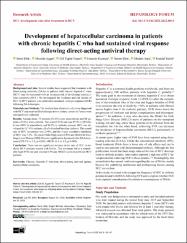Development of hepatocellular carcinoma in patients with chronic hepatitis C who had sustained viral response following direct-acting antiviral therapy

Göster/
Erişim
info:eu-repo/semantics/closedAccessTarih
2022Yazar
Ebik, BeratAygan, Mustafa
Tuncel, Elif Tuğba
Kaçmaz, Hüseyin
Ekin, Nazım
Arpa, Medeni
Yalçın, Kendal
Üst veri
Tüm öğe kaydını gösterKünye
Ebik, B., Aygan, M., Tuncel, E. T., Kacmaz, H., Ekin, N., Arpa, M., & Yalcin, K. (2022). Development of hepatocellular carcinoma in patients with chronic hepatitis C who had sustained viral response following direct-acting antiviral therapy. Hepatology forum, 3(3), 82–87. https://doi.org/10.14744/hf.2022.2022.0016Özet
Background and Aim: Several studies have suggested that treatment with direct-acting antivirals (DAAs) in patients with chronic hepatitis C virus (HCV) may be associated with an increased risk of developing hepatocellular carcinoma (HCC). We investigated the incidence and risk factors of HCC in HCV patients who achieved a sustained virologic response (SVR) following DAA therapies.
Materials and Methods: The medical data of patients who were diagnosed with HCV and received DAA therapy in two tertiary centers in Turkey were retrospectively collected.
Results: Among them, 75 patients (52.4%) were noncirrhotic and 68 patients (47.6%) were cirrhotic. The overall SVR rate was 97.2% (139/143). It was 100% in noncirrhotic and 94.1% in cirrhotic patients. HCC was developed in 5 (7.4%) patients, all of whom had baseline cirrhosis. The annual rate of HCC occurrence was 2.94%, and the 5-year cumulative incidence of HCC was 7.3%. The mean Child-Pugh score (CPS) and Model for End-Stage Liver Disease (MELD) score significantly decreased after DAA treatment (CPS 7.0 vs 5.9, p=0.001; MELD 10.8 vs 9.5, =-0.003).
Conclusion: There was no significant increase in the rate of HCC in cirrhotic HCV patients treated with DAAs. This treatment led to a remarkably high SVR rate and lowered CPS and MELD scores in cirrhotic HCV patients.

















